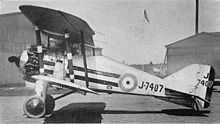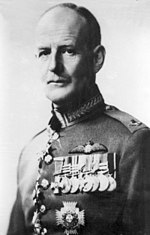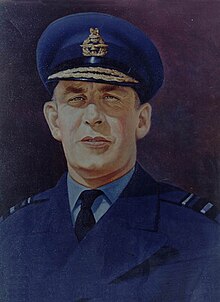Richard Atcherley
Sir Richard Llewelyn Roger "Batchy" Atcherley , KBE , CB , AFC & Bar (born January 12, 1904 in York , Yorkshire , England ; † April 18, 1970 in Aldershot , Hampshire , England) was a British Air Force officer in the Royal Air Force who served under Among other things, he was part of Richard Waghorn's team when he won the Schneider Trophy in 1929 and won the King's Cup Race in 1929 . Most recently he was supreme commander of the Royal Pakistan Air Force between 1949 and 1951 and from 1955 to 1959 in the rank of lieutenant general ( Air Marshal ) supreme commander of the flight training command (RAF Flying Training Command) .
Life
Pilot training and participation in the Schneider Trophy

Richard Llewelyn Roger "Batchy" Atcherley was a son of Sir Llewellyn William Atcherley , Chief Constable of the West Riding of Yorkshire, balloonist and Major General of the British Army during World War I , and his wife Eleanor "Nellie" Frances. His twin brother David Atcherley was also an Air Force officer and most recently in 1952 commander of No. 205 Group RAF . After attending the Oundle School, founded in 1556, he began his officer training as a flight cadet of the A Squadron at the Royal Air Force College Cranwell in 1922 , while his twin brother David Atcherley was rejected there on medical grounds. During his training he was a Flight Cadet Sergeant in the Cadet Corps. After completing his training, he was promoted to lieutenant ( pilot officer ) on July 31, 1924 and taken on as a professional soldier (Permanent Commission) in the Royal Air Force (RAF). First he was named No. 29 Squadron RAF on the military airport offset RAF Duxford, where it biplane - fighter type Sopwith Snipe flew. In 1924 he took part in the " Robert Marsland Groves " flying competition and won first prize. After attending the Central Flying School in 1925 , he initially returned as a flight instructor to No. 29 Squadron RAF back. On October 26, 1925, he switched to the No. 1 position as a pilot and qualified flying instructor QFI (Qualified Flying Instructor) . 23 Squadron RAF at the RAF Henlow military airfield.
After being promoted to first lieutenant ( Flying Officer ) on January 31, 1926, "Batchy" Atcherley became a qualified flight instructor at the Central Flight School on August 4, 1926 and was a member of the school's air show and aerobatic team , the Genet Moths, between 1927 and 1928 , to which the later Marshal of the Royal Air Force Sir Dermot Boyle belonged. On October 6, 1928, he was transferred to the RAF High Speed Flight , a swarm that was put together to participate in the 1929 Schneider Trophy . The team was next to him, among others, Squadron Leader Augustus Orlebar as flight training commander, Flight Lieutenant Samuel Kinkead , Flight Lieutenant George Stainforth and Flying Officer Richard Waghorn , whom he knew since the visit of the RAF College Cranwell and the seaplane Supermarine S.6 with won first place in the Schneider Trophy with an average speed of 528.88 km / h . Atcherley was disqualified from the competition because of the flight into a pylon, but even with the Supermarine S.6 he flew intermittent records over distances of 50 kilometers with an average speed of 534.3 km / h and 100 kilometers with an average speed of 532.69 km / h.
1929 King's Cup Race Winner

In addition, Atcherley took with George Stainforth as navigator on July 6, 1929 at the Heston Aerodrome at the King's Cup Race with a biplane fighter of the Gloster Grebe type and won this race with an average speed of 150 mph. On October 10, 1929, he returned to the Central Flight School as a qualified flight instructor, where he was promoted to captain ( Flight Lieutenant ) on November 13, 1929 , whereupon he became Flight Commander of No. 23 Squadron RAF was. Because of his records, he was invited to take part in the National Air Races at Naval Air Station Glenview near Chicago in August 1930 . Upon arrival, it was clear that his aerobatic demonstration in a standard British light aircraft would miss the American experts in their specially designed high-performance aircraft. So he decided to show a "crazy flying" in which he flew the plane as if it were being flown by an unqualified pilot. His performance was so spectacular that he was asked to return the following year.
On October 13, 1930 Flight Lieutenant Atcherley was flight training commander in Transjordan stationed No. 14 Squadron RAF , so that he had to fly back to Great Britain in his own aircraft to take part in the National Air Races in Cleveland in August 1931 . While in Chicago, he experienced some experiments with air-to-air refueling and was immediately fascinated by them. During his service in Palestine, he carried out night flight and navigation experiments, which he later perfected into an approved night landing system. Another of his eccentricities at the time was his domestic animals, which included a lion that he often took with him. Prior to the Middle East but left him caught up with his antics when he a tennis party of the Supreme Commander of Air Command in the Middle East an aerobatic demonstration ( RAF Middle East Command ) , Sir Cyril Newell conducted. Before a court martial, he lost 50 places in the seniority lists with effect from May 7, 1934, so that the seniority rank as captain was only calculated from May 14, 1934. At the same time, the planned visit to the RAF Staff College, Andover was postponed.
Time until World War II

After returning to Great Britain, Richard Atcherley became a test pilot in September 1934 in the Royal Aircraft Establishment (RAE), the research and development facility of the Royal Air Force at RAF Farnborough . There he continued his research and developments in air refueling, which led to the founding of Flight Refueling Ltd. in 1934 . led by Alan Cobham . He also continued his earlier experiments with night landing systems, even suggesting that crews wear specially designed flight suits based on the ski suit .
Atcherley attended the RAF Staff College, Andover , from January 1937 and was promoted to Major ( Squadron Leader ) on April 1, 1937 . He then moved on January 1, 1938, as a staff officer at the headquarters of the Air Force Training Command ( RAF Training Command ) . In this role he was tasked with increasing the command's performance, which required both aircraft and airfields. He used his own plane to search for suitable airfields and attend public schools. He established the Air Cadet Wing of the Public Schools , with the OTC (Officers' Training Corps) training courses attached to the RAF locations and at least two instructors in each school responsible for training the OTC cadets in air matters. In the following years he set up annual camps for these cadets to improve their flying experience on low-wing aircraft of the Avro Anson type and initial flight training for selected cadets on training aircraft of the De Havilland DH.82 Tiger Moth type .
On July 1, 1939, he moved to the staff of the Inspector General of the Royal Air Force, Air Marshal Sir Charles Stuart Burnett , who was previously Commander in Chief of the RAF Training Command.
Second World War

After the start of World War II Squadron Leader "Batchy" Atcherley on October 4, 1939 was commander ( Officer Commanding ) of No. 219 Squadron RAF . After the operation weserübung , the occupation of Norway by the German Wehrmacht on April 9, 1940 he was in May 1940, commander of the air forces of the British Expeditionary Force (BEF) to the flight operations of fighter aircraft of type Gloster Gladiator of No. 263 Squadron RAF and the Hawker Hurricane fighter aircraft of No. 46 Squadron RAF at Bardufoss Airport to prepare. After the occupation of Norway by the German troops , he organized the successful landing of the British aircraft No. 263 Squadron RAF and No. 46 Squadron RAF on the battlecruiser HMS Glorious , which has been converted into an aircraft carrier , in order to secure it from being conquered and destroyed by the German Wehrmacht. For his services he was awarded the Air Force Cross (AFC). Upon his return, in June 1940, he became the commander of RAF Drem Air Force Base in Scotland , where development of his night landing light system continued, eventually adopted by the RAF and known as the "Drem" system. In 1941 he was then commander of the 54th Operational Training Unit OTU (No. 54 Operational Training Unit) at the RAF Church Fenton military airfield. For his services during this time, he was honored with the Officer's Cross of the Order of the British Empire (OBE) on January 1, 1941 and first mentioned in the war report on March 17, 1941 ( Mentioned in dispatches ) and with one on September 24, 1941 Spange (bar) awarded to the Air Force Cross. He was also awarded the War Cross of Norway with Swords in 1942 .
Subsequently, Atcherley was first in command of the RAF Fairwood Common military airport in 1942 and was replaced in this capacity a short time later by his twin brother David Atcherley, which was not noticed by most of the soldiers stationed there. He himself then became the commander of the RAF Kenley Air Force Base in 1942. On June 11, 1942 he was mentioned again in the war report and on November 20, 1942 promoted to Lieutenant Colonel ( Wing Commander ), this promotion being dated back to October 1, 1941. In his role as the commander of the RAF Kenley Air Force Base, he flew several times to combat missions, which led to protests by the local Squadron Leader , as he noticed the enemy aircraft too late. Thereupon he promised the commander in chief that he would no longer take part in combat missions. In fact, he was shot down over the English Channel the following day . After his rescue and subsequent recovery, he was in the Middle East added, and on April 11, 1943 Commander (Air Officer Commanding) of the air forces in the Western Desert (Western Desert Air Force) belonging No. 211 Group RAF in Tripoli . After falling in a new Curtiss P-40 "Kittyhawk" fighter , he incurred the wrath of Western Desert Air Force Commander Air Vice Marshal Harry Broadhurst and was dismissed from his post.
After his return to Great Britain, Atcherley was appointed head of the training staff division in the Air Assault Command ( RAF Fighter Command ) in 1943 and then, in March 1944, deputy head of the training section of the Allied Expeditionary Air Force ( AEAF ) and was temporarily also acting head of this section. Then he was in July 1944 in command of the Fighter Leaders' School at the military airport RAF Milfield and received on January 1, 1945 for his services again a mention in the war report. On February 25, 1945 he became the first in command of the newly established Central Fighter Establishment , which was responsible for developing new tactics and evaluating new fighter missions. On July 5, 1945 he was named Commandeur of the Order of the British Empire (CBE) for his services . He then briefly Senior Staff Officer SASO was (Senior Air Staff Officer) of newly prepared Tactical Air Force of the Commonwealth of Nations , the Commonwealth Tactical Air Force . After the atomic bombs were dropped on Hiroshima and Nagasaki on August 6 and 9, 1945 and the subsequent surrender of Japan on September 2, 1945, which led to the end of World War II, the planned establishment of the Commonwealth Tactical Air Force was repealed.
Post-war period and promotion to Air Marshal
After the war ended and his return to the United Kingdom, "Batchy" Atcherley was on September 12, 1945 in command of the RAF Cranwell Air Force Base . At the same time, he was the first former graduate in command of the Royal Air Force College Cranwell and held this post until his replacement by Air Commodore George Beamish on January 1, 1949. In this position, he was promoted to Colonel ( Group Captain ) and on July 1, 1947 to Brigadier General ( Air Commodore ). As the commander of RAF College Cranwell, he developed techniques for inspecting the site, its staff, cadets and apprentices, while he himself flew a Gloster Meteor , the first British jet-powered fighter to become operational. On January 31, 1949, he replaced Air Vice Marshal Allan Perry-Keene as Commander-in-Chief of the Royal Pakistan Air Force and held this post until June 1, 1951, when Air Vice Marshal Leslie William Cannon succeeded him. In this capacity he was promoted to Companion of the Order of the Bath (CB) on June 8, 1950 and on January 1, 1951 to Major General ( Air Vice Marshal ).
On June 1, 1951 returned Atcherley for RAF Fighter Command and was back between June 1, 1951 to November 1953 Commander AOC (Air Officer Commanding) of No. 12 Group RAF . He then became Chief of Staff of the British Joint Services Mission in the United States in November 1953 , where he also took flight lessons on the single-engine North American F-86 fighter and the twin-engine Avro Canada CF-100 . Most recently he succeeded Air Marshal Sir Lawrence Pendred as Commander in Chief of the RAF Flying Training Command (RAF Flying Training Command) on December 20, 1955 and held this position until his replacement by Air Marshal Sir Hugh Constantine on March 1, 1959. During his tenure, he introduced instruction on the Percival Provost and Folland Gnat trainer aircraft . On May 1, 1956, he was promoted to Lieutenant General ( Air Marshal ). He was also beaten on May 31, 1956 to Knight Commander of the Order of the British Empire (KBE) and has since had the addition of "Sir". On April 4, 1959, he left active military service and retired. From 1959 to 1965 he was sales director of the aircraft manufacturer Folland Aircraft .
Web links
- Biography on Air of Authority - A History of RAF Organization (English)
- Atcherley, Air Marshal Sir Richard Llewellyn Roger in Who's Who (online version)
| personal data | |
|---|---|
| SURNAME | Atcherley, Richard |
| ALTERNATIVE NAMES | Atcherley, Sir Richard Llewelyn Roger (full name); Batchy (nickname) |
| BRIEF DESCRIPTION | British Air Force officer in the United Kingdom |
| DATE OF BIRTH | January 12, 1904 |
| PLACE OF BIRTH | York , Yorkshire , England |
| DATE OF DEATH | April 18, 1970 |
| Place of death | Aldershot , Hampshire , England |
